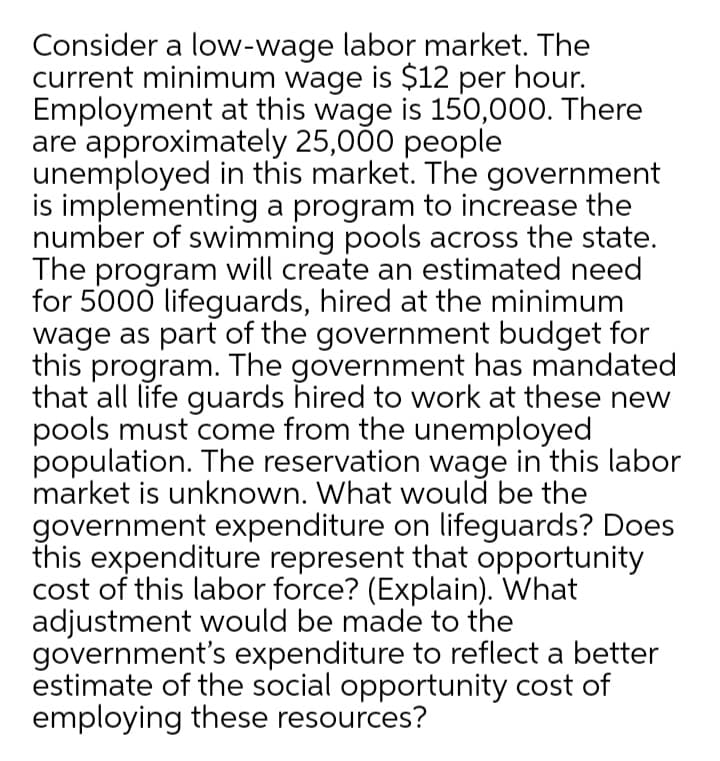Consider a low-wage labor market. The current minimum wage is $12 per hour. Employment at this wage is 150,000. There are approximately 25,000 people unemployed in this market. The government is implementing a program to increase the number of swimming pools across the state. The program will create an estimated need for 5000 lifeguards, hired at the minimum wage as part of the government budget for this program. The government has mandated that all life guards hired to work at these new pools must come from the unemployed population. The reservation wage in this labor market is unknown. What would be the government expenditure on lifeguards? Does this expenditure represent that opportunity cost of this labor force? (Explain). What adjustment would be made to the government's expenditure to reflect a better estimate of the social opportunity cost of employing these resources?
Consider a low-wage labor market. The current minimum wage is $12 per hour. Employment at this wage is 150,000. There are approximately 25,000 people unemployed in this market. The government is implementing a program to increase the number of swimming pools across the state. The program will create an estimated need for 5000 lifeguards, hired at the minimum wage as part of the government budget for this program. The government has mandated that all life guards hired to work at these new pools must come from the unemployed population. The reservation wage in this labor market is unknown. What would be the government expenditure on lifeguards? Does this expenditure represent that opportunity cost of this labor force? (Explain). What adjustment would be made to the government's expenditure to reflect a better estimate of the social opportunity cost of employing these resources?
Micro Economics For Today
10th Edition
ISBN:9781337613064
Author:Tucker, Irvin B.
Publisher:Tucker, Irvin B.
Chapter11: Labor Markets
Section: Chapter Questions
Problem 2SQP
Related questions
Question

Transcribed Image Text:Consider a low-wage labor market. The
current minimum wage is $12 per hour.
Employment at this wage is 150,000. There
are approximately 25,000 people
unemployed in this market. The government
is implementing a program to increase the
number of swimming pools across the state.
The program will create an estimated need
for 5000 lifeguards, hired at the minimum
wage as part of the government budget for
this program. The government has mandated
that all life guards hired to work at these new
pools must come from the unemployed
population. The reservation wage in this labor
market is unknown. What would be the
government expenditure on lifeguards? Does
this expenditure represent that opportunity
cost of this labor force? (Explain). What
adjustment would be made to the
government's expenditure to reflect a better
estimate of the social opportunity cost of
employing these resources?
Expert Solution
This question has been solved!
Explore an expertly crafted, step-by-step solution for a thorough understanding of key concepts.
Step by step
Solved in 2 steps with 1 images

Knowledge Booster
Learn more about
Need a deep-dive on the concept behind this application? Look no further. Learn more about this topic, economics and related others by exploring similar questions and additional content below.Recommended textbooks for you



Principles of Economics 2e
Economics
ISBN:
9781947172364
Author:
Steven A. Greenlaw; David Shapiro
Publisher:
OpenStax



Principles of Economics 2e
Economics
ISBN:
9781947172364
Author:
Steven A. Greenlaw; David Shapiro
Publisher:
OpenStax

Principles of Microeconomics
Economics
ISBN:
9781305156050
Author:
N. Gregory Mankiw
Publisher:
Cengage Learning

Principles of Macroeconomics (MindTap Course List)
Economics
ISBN:
9781305971509
Author:
N. Gregory Mankiw
Publisher:
Cengage Learning

Essentials of Economics (MindTap Course List)
Economics
ISBN:
9781337091992
Author:
N. Gregory Mankiw
Publisher:
Cengage Learning